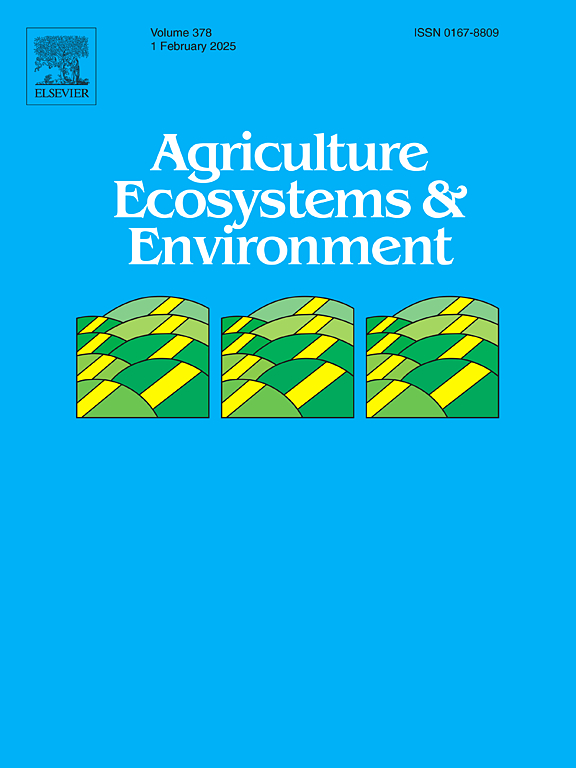Tree and landscape characteristics outweigh insect abundance in driving bat activity in West African rice fields
IF 6.4
1区 农林科学
Q1 AGRICULTURE, MULTIDISCIPLINARY
引用次数: 0
Abstract
The urgent need to sustainably feed a growing human population is particularly pressing in tropical regions where food security remains uncertain. Ecological intensification strategies, such as integrating nature-based solutions, can help achieve this goal by leveraging ecosystem services. Isolated trees in agricultural landscapes play a vital role in enhancing productivity and biodiversity, supporting organisms like insectivorous bats that provide pest control services. The implementation of measures to strengthen insectivorous bat populations holds significant potential to increase insect predation, suppress agricultural pests, and improve food security. Understanding how tree characteristics and surrounding landscapes influence bat foraging activity in staple tropical crops is thus essential. This study investigated how isolated trees influence the activity of bats and insects in smallholder rice fields in Guinea-Bissau. Specifically, we evaluated how tree characteristics and landscape features affect bat guild activity, insect abundance, and richness, as well as the indirect effects of insects on bats. Our findings indicate that larger, isolated trees of specific species located closer to other trees but further from wooded edges are associated with increased bat activity and richness, mediated partly by higher insect abundance. These results emphasise the ecological and agricultural importance of isolated trees in promoting biodiversity and enhancing pest suppression in agricultural landscapes.
在西非稻田,树木和景观特征在驱动蝙蝠活动方面超过昆虫丰度
在粮食安全仍不确定的热带地区,以可持续方式养活不断增长的人口的迫切需求尤为迫切。生态集约化战略,如整合基于自然的解决方案,可以通过利用生态系统服务来帮助实现这一目标。农业景观中的孤立树木在提高生产力和生物多样性方面发挥着至关重要的作用,为提供害虫控制服务的食虫蝙蝠等生物提供支持。实施加强食虫蝙蝠种群的措施,在增加昆虫捕食、抑制农业害虫和改善粮食安全方面具有巨大潜力。因此,了解树木特征和周围景观如何影响蝙蝠在主要热带作物上的觅食活动至关重要。本研究调查了孤立树木如何影响几内亚比绍小农稻田中蝙蝠和昆虫的活动。具体而言,我们评估了树木特征和景观特征如何影响蝙蝠行会活动、昆虫丰度和丰富度,以及昆虫对蝙蝠的间接影响。我们的研究结果表明,距离其他树木更近但远离树木边缘的特定物种的较大,孤立的树木与蝙蝠活动和丰富度的增加有关,部分原因是更高的昆虫丰度。这些结果强调了孤立树木在促进农业景观生物多样性和加强害虫抑制方面的生态和农业重要性。
本文章由计算机程序翻译,如有差异,请以英文原文为准。
求助全文
约1分钟内获得全文
求助全文
来源期刊

Agriculture, Ecosystems & Environment
环境科学-环境科学
CiteScore
11.70
自引率
9.10%
发文量
392
审稿时长
26 days
期刊介绍:
Agriculture, Ecosystems and Environment publishes scientific articles dealing with the interface between agroecosystems and the natural environment, specifically how agriculture influences the environment and how changes in that environment impact agroecosystems. Preference is given to papers from experimental and observational research at the field, system or landscape level, from studies that enhance our understanding of processes using data-based biophysical modelling, and papers that bridge scientific disciplines and integrate knowledge. All papers should be placed in an international or wide comparative context.
 求助内容:
求助内容: 应助结果提醒方式:
应助结果提醒方式:


